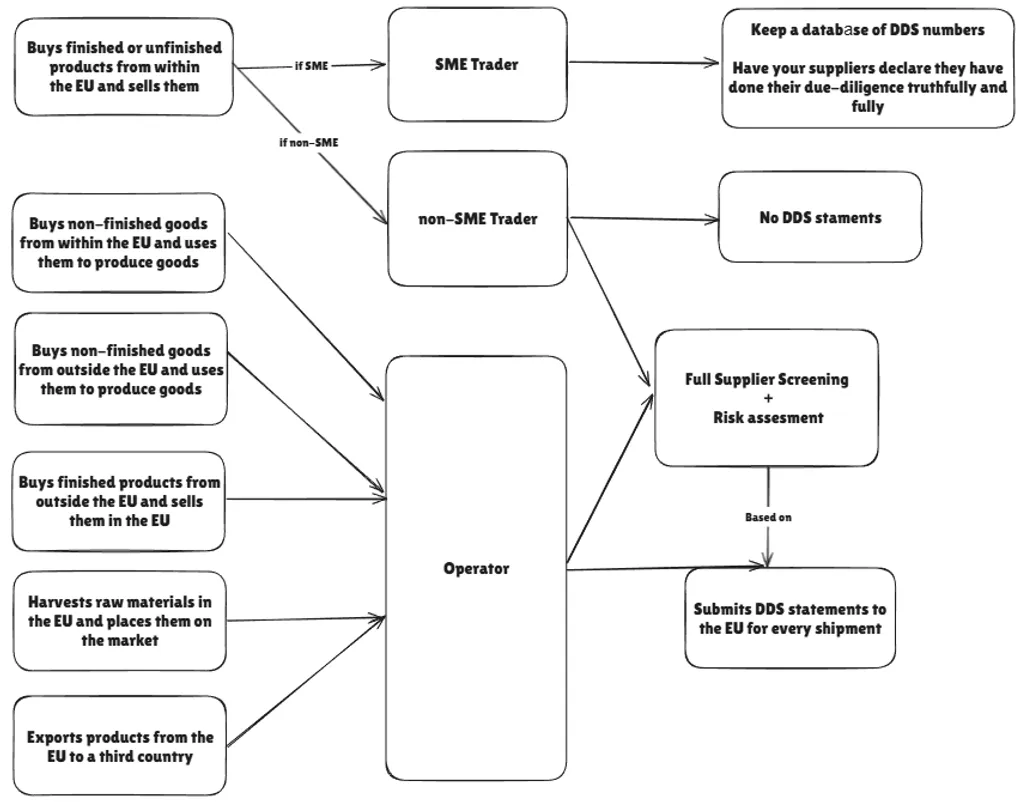
What is EUDR and does it concern you
EUDR is the nickname of REGULATION (EU) 2023/1115 OF THE EUROPEAN PARLIAMENT AND OF THE COUNCIL of 31 May 2023 on the making available on the Union market and the export from the Union of certain commodities and products associated with deforestation and forest degradation and repealing Regulation (EU) No 995/2010.
It sounds like nothing but trouble, we know, so here’s the TLDR:
- What it covers: The regulation applies to seven commodities and their derived products: cattle, cocoa, coffee, oil palm, rubber, soya, and wood. This includes items like beef, chocolate, furniture, and tires.
- The core requirements:
- Deforestation-free: The products must not have been produced on land that was deforested or subjected to forest degradation after December 31, 2020. This is a strict definition that includes both illegal and legal deforestation.
- Legally produced: The products must also comply with all relevant laws of the country of production, including those on land use, environmental protection, and human rights.
- Deforestation-free: The products must not have been produced on land that was deforested or subjected to forest degradation after December 31, 2020. This is a strict definition that includes both illegal and legal deforestation.
- Legally produced: The products must also comply with all relevant laws of the country of production, including those on land use, environmental protection, and human rights.
- Due diligence: Companies must perform rigorous due diligence to ensure compliance. This includes:
- Collecting information and data, such as the geographic coordinates of the land where the commodities were produced
- Conducting a risk assessment to determine if there is a risk of non-compliance.
- Implementing risk mitigation measures if a risk is identified.
- Enforcement: Non-compliance can lead to severe penalties, including fines of up to 4% of a company’s annual EU turnover, confiscation of goods, and a ban from the EU market for repeat offenders.
- Timeline: The new rules became applicable on December 30, 2025, for most companies, with a later date of June 30 2026 for micro and small enterprises.
If you don’t deal with any of the goods above in any way, shape or form, feel free to breathe a sigh of relief. If you are unsure whether or not you do, go to page 38 of the Regulation and take a look at the exhaustive list of commodities affected. If none of them are in your warehouse and never have been – relax, you are unaffected.
If you are affected, though, strap in.
Besides the actual requirements, the most difficult thing for companies to figure out is to what extent they apply to them. The Regulation makes a clear distinction between Operators and Traders and further between SMEs and non-SMEs.
Traders are exactly what they sound like – resellers of EUDR-affected products that have already been placed on the EU market by a previous party. As long as traders are an SME, they are only required to keep a database of the due-diligence the previous parties have filed with the EU. If Traders are non-SMEs, then they are effectively Operators in terms of due-diligence requirements.
Operators bear the majority of the bureaucratic load of the EUDR and almost all of the responsibility.
An operator is the entity that first places a relevant product on the EU market or exports it from the EU. This includes:
- An importer bringing products from outside the EU into the EU.
- An EU-based company that transforms a relevant product (e.g., uses cocoa butter to make chocolate) and then places the new product on the market.
- An entity that harvests a relevant commodity within the EU and then makes it available on the EU market.
- An exporter shipping products from the EU to a non-EU country.
Here is a chart to clear things up:

As much as it may seem otherwise, most companies are Traders – there is just a lot of specific cases that fall in the Operators category. However, all the unspecified ones are Traders, so if you can’t recognize your specific case on the chart, you are almost definitely a Trader.
Feel free to contact our expert team on our free help line and we will guide you through the hoops of figuring out what EUDR requires you to do!